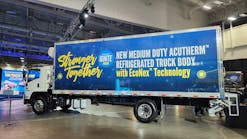How this new composite material could change refrigerated transportation
LOUISVILLE, Kentucky—Wabash unveiled a medium-duty truck body made of a new composite material that could make refrigerated transportation a more efficient and green industry.
Transportation today faces constant pressure to become more energy efficient. With this new composite technology, refrigerated transportation’s next big step in temperature control efficiency is happening in the very structure of the refrigerated body.
“The market has not seen a new way of constructing refrigerated truck bodies for half a century,” Kevin Sumrak, senior director of sales and truck body strategy for Wabash, told FleetOwner. “That’s why it’s something that’s really revolutionary in the refrigerated market today.”
At Wabash’s 2024 conference in Louisville, Wabash Ignite, the company displayed its new medium-duty truck using the composite: the Wabash Acutherm refrigerated freight body with EcoNex Technology.
EcoNex, the company's proprietary technology, replaces conventional refrigerated truck body construction, using what Wabash says is a significantly lighter and 25% more thermally efficient build.
Structure and insulation in one material
Less moisture intrusion
The tight composition of a truck body using EcoNex panels also means less water intrusion, according to Wabash.
“With conventional construction, you actually have open areas on the ends where the wall would fit into the extrusions and other areas in the construction that allow water to penetrate the wall and get into the insulation,” Sumrak told FleetOwner. “With EcoNex, you don’t have that.”
The construction of the composite panels, including the composite’s protective gel coat, introduces fewer voids in the body. The panels are then significantly less likely to absorb water over the life of the body, Sumrak said. Less moisture intrusion means even greater comparative thermal efficiency as the body ages.
Energy saved
Greater overall thermal efficiency means that fleets have to spend less energy powering transportation refrigeration units.
“Many of our fleets will run the refrigeration unit roughly 1,600 to 2,000 hours a year just to keep the product cold,” Clickenbeard explained. “That’s utilizing half a gallon of diesel per hour. If we say 1,600 hours a year and you improve 25% on that, that’s 400 hours that you’re not running your refrigeration unit.”
Smaller carbon footprint
A truck body using these composite panels saves more than just TRU hours.
Because a body using the panels needs no metal frame, manufacturing requires less metal production. Minimizing steel and aluminum production, both highly carbon-intensive processes, means a smaller carbon footprint for the vehicle.
Energy savings for the body also go beyond TRU use. With a lighter overall weight compared to traditional bodies (about 700 lb.), the medium-duty truck body using EcoNex panels would require less fuel or energy to move.
With the onset of electric vehicles, limited range makes energy efficiency crucial, while heavy batteries make lightweight builds advantageous.
“It’s great for ICE engines, and I would say it’s even better for EVs,” Sumrak said.



